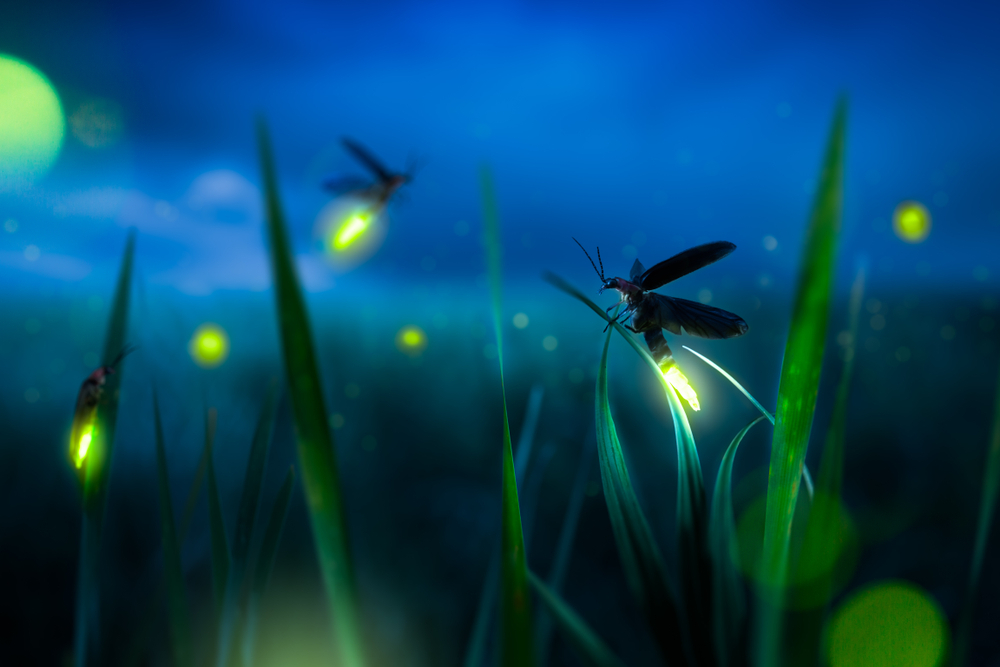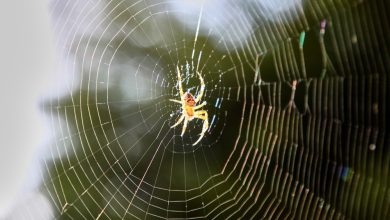Flickering Through the Darkness: 10 Captivating Facts About Fireflies

Welcome to our blog post, “Flickering Through the Darkness: 10 Captivating Facts About Fireflies.” Fireflies, or lightning bugs as they are sometimes called, are among the most enchanting creatures of the night.
These tiny beetles are not just another pretty sight; they hold a unique place in the nocturnal tableau of nature. With their ability to emit light through bioluminescence—a chemical reaction that allows them to glow in the dark—fireflies transform woodlands, fields, and gardens into a flickering fairyland as night falls.
This magical ability not only sets them apart from other insects but also serves as a critical tool in their survival, aiding in communication and mating.
In this post, we’ll explore the wondrous world of fireflies, shedding light on how and why they glow, the significance of their light patterns, their cultural impact across the globe, and much more.
Join us as we unravel the mystery behind these luminous beings and discover the role they play in the tapestry of the natural world.
1. The Science of Glow
Diving into the science behind the enchanting glow of fireflies leads us directly to the fascinating process of bioluminescence. This natural phenomenon occurs when fireflies convert chemical energy into light energy with little to no heat produced, a trait that sets bioluminescence apart from other forms of light production.
At the heart of this process are two key components: a light-emitting molecule called luciferin and an enzyme known as luciferase. When oxygen combines with luciferin and luciferase inside a firefly’s body, it sparks a chemical reaction that emits the glow we see.
This glow serves a dual purpose – not only does it help fireflies stand out in the nighttime for mating purposes, but it also acts as a defense mechanism, deterring predators by signaling the firefly’s potential toxicity.
Thus, the glow of a firefly is not just a magical spectacle for humans to enjoy; it’s a crucial survival tool in the firefly’s arsenal, beautifully entwining function with nature’s artistry.
2. Not Just a Pretty Light
The luminous display of fireflies serves a purpose far beyond merely enchanting human onlookers; it’s a vital form of communication within the species, especially in their complex mating rituals. Each firefly species has a unique pattern of light signals that function essentially as a code to attract mates.
Males fly about at night emitting a series of flashes, while females, typically stationary, respond with their own specific flash pattern. This bioluminescent ‘conversation’ enables potential mates to find each other in the dark.
Furthermore, these light patterns can vary significantly, ranging from steady glows to rapid bursts of light, depending on the species and even the environmental conditions.
Intriguingly, some species of firefly use these signals in a more deceptive manner; female fireflies of certain species mimic the flash patterns of other species to lure unsuspecting males, not for mating, but as prey.
This complex use of bioluminescence highlights not only the aesthetic wonder of fireflies but also the intricate and sometimes perilous dance of their nocturnal life.
3. A Worldwide Phenomenon
Fireflies enchant observers not just in one specific locale but span the globe, illuminating night skies from North and South America to Europe and Asia, creating a worldwide phenomenon that captivates people across continents.
This wide distribution across varied climates and regions is a testament to the adaptability and diverse habitats of firefly species.
They thrive in environments ranging from humid tropical forests to temperate woodlands and marshes, each ecosystem providing the unique conditions necessary for their survival.
In the balmy nights of Southeast Asia, for instance, certain species synchronize their flashes in unison, creating spectacular displays that attract tourists from around the world.
Meanwhile, in the more temperate climates of North America, different varieties signal the onset of summer with their individual luminous performances.
The habitat diversity not only underscores the ecological versatility of these insects but also highlights the importance of preserving these environments to ensure the continued survival of fireflies worldwide.
4. The Lifespan of a Luminary
The life cycle of a firefly is a fascinating process, encompassing several distinct stages from egg to adult. This cycle begins when a female firefly lays her eggs in the ground, which is a carefully chosen environment—moist and rich in food sources such as snails, worms, and other small invertebrates.
After a few weeks, the eggs hatch, releasing larvae known as glowworms due to their ability to produce light, a trait they retain from their earliest stages of life.
These larvae are voracious predators, using their bioluminescence to attract prey and then feeding on them to gather energy for the next phase of their life cycle.
After spending one to two years in the larval stage, during which they grow and molt multiple times, the larvae enter a pupal stage. In this stage, they encase themselves in a cocoon-like structure in the soil, undergoing a metamorphosis that transforms them into adult fireflies.
This transformation, which can take anywhere from a few weeks to several months depending on environmental conditions, sees the firefly emerge fully formed, with wings that enable it to fly and continue the species’ cycle of life.
The adult phase of a firefly’s life is primarily focused on reproduction. Adults typically live for a few weeks, during which they engage in the complex mating rituals that involve their famous bioluminescent signaling. After mating, females lay their eggs, and the cycle begins anew.
Unfortunately, the lifespan of adult fireflies is quite short, emphasizing the importance of each stage in the life cycle for the continuation of the species. This cyclical nature of life and light ensures the ongoing spectacle of firefly bioluminescence in our night skies.
5. Predators and Protection
The adult phase of a firefly’s life is primarily focused on reproduction. Adults typically live for a few weeks, during which they engage in the complex mating rituals that involve their famous bioluminescent signaling. After mating, females lay their eggs, and the cycle begins anew.
Unfortunately, the lifespan of adult fireflies is quite short, emphasizing the importance of each stage in the life cycle for the continuation of the species. This cyclical nature of life and light ensures the ongoing spectacle of firefly bioluminescence in our night skies.
Fireflies, while enchanting, are not without their natural adversaries. Among their predators are birds, spiders, and frogs, all drawn to the fireflies’ light, mistaking it for a potential meal.
However, these luminous insects are not defenseless; their glow serves as a warning signal, an evolutionary adaptation that communicates their unpalatability.
The chemicals responsible for their bioluminescence, when ingested, can be toxic or distasteful to many of their would-be predators, effectively discouraging further attempts.
This biological defense mechanism is a fascinating example of how fireflies use their most famous feature, not just for attraction and communication within their species, but also as a means of survival against predation. The dual purpose of their light—both beckoning and warning—underscores the complex interplay between beauty and survival in the natural world.
6. Cultural Significance
The cultural significance of fireflies transcends mere biological fascination, weaving these luminous creatures into the folklore and celebrations of various cultures around the world.
In Japan, for example, fireflies, known as “hotaru,” are emblematic of passionate love in poetry and art, celebrated in annual festivals that honor their ephemeral beauty and the poignant impermanence they symbolize.
Villages host evenings dedicated to watching fireflies, creating moments of collective reverence for nature’s delicate balance.
Similarly, in many Native American traditions, fireflies are seen as carriers of light in the darkness, guiding lost souls and symbolizing hope. They’re often depicted in stories and myths as messengers that possess the power to lead one back to their spiritual path.
In other parts of Asia, such as Malaysia and the Philippines, fireflies are associated with magical qualities, lighting up rivers and forests in synchronized displays that are considered to bring blessings and good luck to communities.
These cultural interpretations highlight how deeply entwined fireflies are with human sentiment and spirituality, embodying themes of love, mortality, guidance, and mysticism across global societies.
7. Conservation Status
The conservation status of fireflies worldwide is becoming a growing concern, with several factors threatening their populations and the magical displays they provide.
Habitat destruction stands at the forefront of these challenges, as urbanization, agricultural expansion, and deforestation strip away the natural environments fireflies thrive in.
Additionally, light pollution from expanding cities and towns significantly disrupts firefly mating rituals, as their bioluminescent signals get lost in the glare of artificial lighting, leading to decreased reproduction rates.
The use of pesticides further exacerbates their decline, poisoning the very ground where fireflies lay their eggs and where larvae develop.
Conservation efforts are underway to address these threats, focusing on habitat preservation, reducing light pollution through ‘dark sky’ initiatives, and advocating for the use of environmentally friendly farming practices.
By raising awareness and promoting specific conservation measures, there is hope to halt the decline of these luminescent insects and preserve their light shows for future generations to marvel at.
8. Fireflies as Environmental Indicators
Fireflies, with their enchanting nocturnal light shows, serve as more than just a fascinating aspect of nature’s display; they are also vital environmental indicators.
These luminescent insects are highly sensitive to changes in their ecosystems, making their presence, or lack thereof, a clear signal of the overall health of an environment.
Their reliance on specific conditions for breeding and survival, including clean water bodies and undisturbed habitats, means that a decline in firefly populations often points to underlying ecological problems.
For instance, a decrease in firefly sightings in an area can alert conservationists and environmental scientists to issues such as water pollution, habitat destruction, or excessive use of pesticides.
Conversely, a thriving firefly population is usually indicative of a healthy, well-balanced ecosystem, showcasing the effectiveness of conservation efforts or the resilience of a natural habitat.
Thus, observing and studying these creatures can provide crucial insights into the success of environmental protection measures, offering a flickering beacon of hope in the fight against ecological degradation.
9. Experiencing the Magic
Experiencing the magic of fireflies illuminating the night sky can be a mesmerizing and unforgettable experience, but it’s important to approach these encounters with respect and sensitivity towards the fireflies and their natural habitats.
To fully enjoy the spectacle while ensuring the well-being of these luminescent creatures, consider venturing out during their peak activity times in the warm summer months, just after sunset.
Choosing locations known for firefly activity, away from city lights and disturbances, can greatly enhance your chances of witnessing their dance.
When observing fireflies, minimize the use of artificial lights, including flashlights and smartphone screens, as this can disrupt their natural behaviors and mating rituals. Instead, allow your eyes to adjust to the natural darkness, and you’ll find the fireflies’ light show all the more astonishing.
Additionally, while it may be tempting to catch fireflies, it’s best to enjoy their beauty without interference, ensuring they continue their essential life processes undisturbed.
Remember, photographs and memories can capture the moment perfectly, without impacting the environment. By following these simple guidelines, we can all partake in the wonder of fireflies, contributing to the preservation of their magical displays for generations to come.
10. Capturing Light
Fireflies have long captivated the human imagination, illuminating the worlds of art, literature, and popular culture with their enchanting glow. In the realm of art, fireflies often serve as symbols of fleeting beauty and the ephemeral nature of life, immortalized in paintings and poetry that seek to capture their delicate luminance.
Literature, too, is rich with references to these luminous creatures, where they frequently appear as motifs that embody moments of fleeting wonder and inspiration, or as metaphors for ideas as diverse as love, hope, and the solitary gleam of creativity in the darkness of despair.
Popular culture has not been immune to their allure either; fireflies have inspired songs, movies, and countless other forms of media, often used to evoke a sense of magic, mystery, and a connection to the natural world.
Their gentle glow offers storytellers and artists alike a symbol ripe with possibility, a way to explore themes of light amidst darkness, and the delicate balance between the transcendent and the transient.
Conclusion
In the fleeting glimpses of light that punctuate the night’s darkness, fireflies offer us a gateway to the marvels of the natural world. These tiny creatures, with their soft glow and serene flights, not only enchant the night but also remind us of the fragile beauty our planet harbors.
“Flickering Through the Darkness: 10 Captivating Facts About Fireflies” has taken us on a luminous journey to uncover the secrets and splendors of these remarkable insects, revealing their importance beyond mere beauty. They serve as crucial environmental indicators, their presence signaling the health of ecosystems, and their decline warning us of ecological instability.
The enchantment that fireflies bring to our evenings is but a whisper of the broader, interconnected miracles of nature that often go unnoticed or unappreciated. Their struggle against the encroaching threats of habitat destruction, light pollution, and chemical interference is our call to action.
It beckons us to not only stand in awe of these luminous beings but to step forward in preserving the delicate balance of our environment. Through understanding, respect, and protective measures, we have the power to ensure that fireflies continue to illuminate our nights, serving as a reminder of nature’s resilience and beauty.
Protecting fireflies and their habitats is, in essence, protecting the myriad small miracles that adorn our world, often hidden in plain sight. It is a commitment to fostering a world where nature’s wonders remain vibrant and vital, flickering through the darkness, guiding us towards a future where both human and natural realms flourish in harmony.
As we draw to a close on our mystical voyage through “Flickering Through the Darkness: 10 Captivating Facts About Fireflies,” it’s clear that these nocturnal luminaries do more than just enchant our summer nights. They play a pivotal role in the intricate ballet of our ecosystems and serve as sentinels warning us of environmental shifts that might otherwise go unnoticed.
The shimmering dance of fireflies across meadows, forests, and fields is not just a spectacle—it’s a dialogue with nature, inviting us to engage more deeply with the world around us. This is where your role begins. A single individual’s passion, compounded with collective action, can ignite significant change. We encourage you, our readers, to become active participants in local conservation efforts.
Engage with community groups, support initiatives aimed at preserving natural habitats, and contribute to the discourse on sustainable practices. Every action, no matter how small, can have a profound impact on maintaining the delicate balance of our ecosystems.
Furthermore, we invite you to share your experiences and knowledge about fireflies with others. Whether it’s through social media, community talks, or educational workshops, spreading awareness is crucial. By sharing stories of enchanting encounters with fireflies or explaining their ecological importance, you can inspire others to appreciate and protect these magical creatures.
Together, by taking steps to preserve their habitats and spreading the wonder they inspire, we can ensure that fireflies continue to light up our nights for generations to come. Join us in safeguarding these flickers of joy and wonder. Your actions today can help preserve the beauty of tomorrow’s nights, allowing fireflies to continue their age-old dance through the darkness, sparking both imagination and conservation in the hearts of those who witness their glow.
Remember, every effort counts in the quest to protect the enchanting world of fireflies and their place within our natural heritage. Start today, for a brighter, more magical tomorrow.




